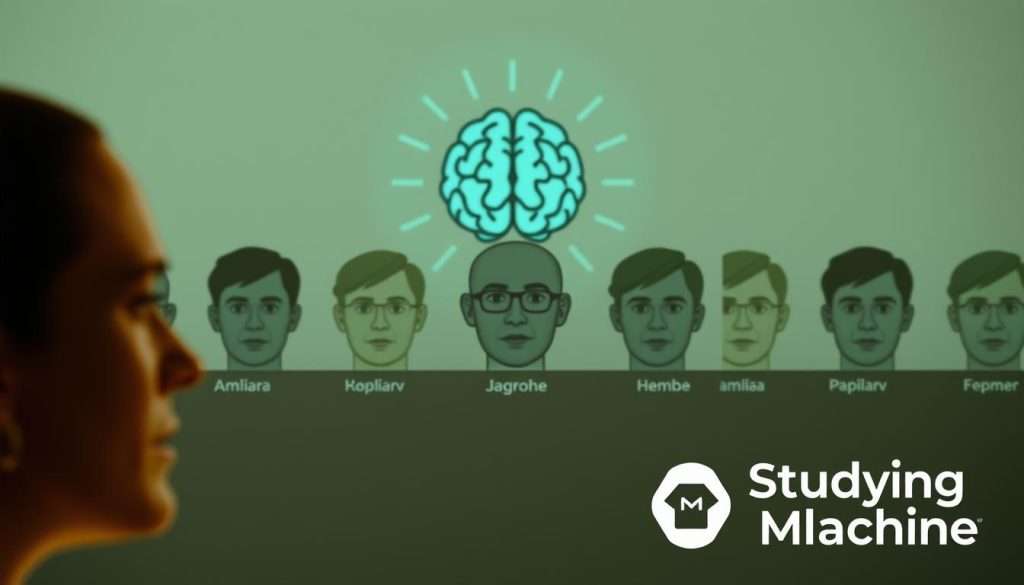Ever had trouble remembering something important, like a password? We’ve all been there! But what if you could remember things easily? That’s where memory techniques come in.
Mnemonics are great tools to help you remember new stuff. They make it easier by linking new info to something you already know. Using memorization strategies like acronyms, rhymes, or pictures can boost your memory.
Key Takeaways
- Discover how to use mnemonics to enhance your memory
- Learn effective memory techniques to improve recall
- Understand how to apply memorization strategies in everyday life
- Unlock your memory’s full potential with simple, yet powerful methods
- Improve your ability to remember crucial information with ease
What Are Mnemonics and Why They Matter
Mnemonics are powerful tools that can greatly improve your memory and learning. They use the brain’s natural ability to remember patterns and connections. This makes it easier to recall information.
The Science Behind Memory Enhancement
Our brains are wired to notice patterns and connections. This makes mnemonic devices very effective. They help the brain link different pieces of information, boosting memory.
How Mnemonics Transform Information Processing
Mnemonics do more than just help you remember. They change how you process information. They create mental shortcuts, making complex data easier to handle. This is great for learning new skills or studying for exams.
The Cognitive Benefits of Active Recall
Active recall, a key part of mnemonics, strengthens memory. It makes the brain work harder to recall information. This active engagement improves retention and understanding. Some benefits include:
- Improved memory retention
- Enhanced ability to recall information under stress
- Better understanding of complex concepts
By using mnemonics every day, you can unlock your full learning potential. You’ll make the most of your memory.
The History and Evolution of Mnemonic Techniques
Mnemonics have a long history, dating back thousands of years. They were first used by ancient civilizations to improve memory. These techniques helped people remember important information.
Ancient Memory Methods from Greece and Rome
In ancient Greece and Rome, orators and philosophers used mnemonics. They remembered speeches and key facts. The method of loci, or “memory palace,” was a favorite among them.
Modern Applications of Traditional Techniques
Today, these old methods are still used in new ways. They’re seen in memory competitions and memory training programs. Here’s a table showing some traditional techniques and their modern uses.
| Traditional Technique | Modern Application |
|---|---|
| Method of Loci | Memory Competitions |
| Acronyms and Acrostics | Study Techniques for Students |
| Rhymes and Songs | Language Learning Tools |
Learning about mnemonic techniques’ history shows their lasting value. They’re still great for improving memory and keeping information in mind.
How Your Brain Stores and Retrieves Information
It’s important to know how our brains handle information. This includes complex pathways that help us remember and recall. It’s all about unlocking our memory’s full potential.
Short-term vs. Long-term Memory Processes
Our brains have different ways to handle short-term and long-term memory. Short-term memory, or working memory, holds info for a few seconds. Then, it’s either forgotten or moved to long-term memory. Long-term memory keeps info for a long time, sometimes forever.
The Role of Associations in Memory Formation
Associations are key in forming memories. When we connect new info to something we already know, it’s easier to remember. Mnemonics work well because they create these connections, making recall easier.
Why Emotional Connections Strengthen Recall
Emotions make memories stick. When info is tied to an emotional experience, we’re more likely to remember it. The brain favors emotional experiences, making them more memorable.
“Emotions are the chief source of human memory, influencing what we remember and how we recall past events.”
| Memory Type | Characteristics | Duration |
|---|---|---|
| Short-term | Temporary holding of information | A few seconds |
| Long-term | Permanent storage of information | Extended periods, sometimes a lifetime |
Understanding how our brains handle info helps us use techniques like mnemonics. By using associations and emotional connections, we can improve our memory. This makes recalling information easier.
The Most Powerful Types of Mnemonics for Everyday Use
Everyday memory challenges can be overcome with the right mnemonic strategies. Mnemonics are powerful tools that help simplify complex information. This makes it easier to remember and recall.
Acronyms and Acrostics: Creating Memory Shortcuts
Acronyms and acrostics are effective mnemonics that help create memory shortcuts. For instance, using the acronym SCUBA to remember Self-Contained Underwater Breathing Apparatus is a classic example. Similarly, an acrostic like “Please Excuse My Dear Aunt Sally” helps remember the order of operations in mathematics: Parentheses, Exponents, Multiplication and Division, and Addition and Subtraction.
Visualization Techniques: The Picture Superiority Effect
Visualization leverages the Picture Superiority Effect, where information is better remembered when associated with images. For example, picturing a familiar place and associating it with the information you want to remember can be highly effective. This technique is particularly useful for remembering names, faces, and complex data.
Chunking Methods: Breaking Down Complex Information
Chunking involves breaking down complex information into smaller, manageable chunks. A common example is breaking down phone numbers into segments (e.g., 123-456-7890). This method reduces cognitive overload and enhances recall.
| Mnemonic Technique | Description | Example |
|---|---|---|
| Acronyms | Using initials to form a word | SCUBA |
| Acrostics | Creating a sentence from initial letters | Please Excuse My Dear Aunt Sally |
| Visualization | Associating information with images | Picturing a map to remember locations |
| Chunking | Breaking down information into chunks | 123-456-7890 |
The Method of Loci: Building Your Memory Palace
Imagine having a mental storage system that can hold vast amounts of information. This is what the method of loci, also known as the memory palace technique, offers. It helps you remember details by linking them to specific locations in your mind.
Step-by-Step Guide to Creating Your First Memory Palace
To start building your memory palace, follow these steps:
- Choose a familiar place: Pick a place you know well, like your home or school.
- Visualually map the space: Imagine walking through the place, noting its features and areas.
- Associate information with locations: Connect the information you want to remember with specific spots in your mind.
- Practice and rehearse: Keep practicing by walking through your memory palace and recalling the information.
As you get better, you can add more locations or paths to your memory palace.
Advanced Techniques for Multiple Memory Palaces
Once you’re good at one memory palace, you can make more for different information. For example, one for historical dates and another for scientific formulas.
Maintaining and Refreshing Your Mental Landscapes
To keep your memory palaces working well, regularly visit and update them. This means:
- Refreshing your mental map: Update your memory palace with new information or changes.
- Rehearsing regularly: Practice often to keep the information in your long-term memory.
- Expanding your palaces: Add new locations or paths as needed to hold more information.
By using these methods and keeping your memory palaces up to date, you can greatly improve your memory.
Mastering Name and Face Association
Improving your memory for names and faces is possible with the right strategies. In social settings, remembering someone’s name can greatly impact how you connect with them. Let’s look at some effective ways to remember names and faces better.

Converting Names into Memorable Images
One effective way to remember names is to turn them into memorable images. For example, if you meet someone named “Rose,” picture a rose flower with their face or a unique feature. The more unusual or vivid the image, the easier it is to remember.
Linking the image to the person’s face or a distinctive trait can help. For instance, if someone has a big nose, picture a rose growing from it. The goal is to create a vivid, unusual association that connects the name to the face.
Practical Exercises for Social Situations
Practicing is key to mastering name and face association. Here are some exercises to try in social situations:
- When you meet someone new, repeat their name in your head and link it to a memorable image.
- Try to recall the names of people you’ve recently met by visualizing their faces and associated images.
- In conversations, mentally connect the person’s name with their story or a characteristic.
Regular practice will make these skills more natural and improve your memory for names and faces.
Retrieval Practice for Long-term Retention
Retrieval practice is vital for long-term memory. After meeting someone, try to recall their name without looking at any cues. This active recall strengthens your memory and makes it easier to remember the name later.
“The more you practice retrieving information, the more likely you are to remember it later.”
Regular retrieval practice can greatly improve your ability to recall names and faces over time.
By using techniques like converting names into memorable images and practicing retrieval, you can significantly boost your ability to remember names and faces. With consistent practice, these skills will become second nature, improving your social interactions and helping you build stronger connections.
Numeric Mnemonics: Remembering Numbers with Ease
Unlock the secret to remembering numbers with ease using numeric mnemonics. We often struggle to recall numbers, whether it’s a PIN, password, or an important date. Numeric mnemonics offer a solution by associating numbers with words or images, making them more memorable.
The Major System Explained
The Major System is a powerful technique for remembering numbers. It converts numbers into consonant sounds, which are then formed into words. This system is based on a phonetic code where each number is associated with a specific sound.
For example, the number 1 is associated with the sounds “t” or “d”. By converting numbers into words, you can create memorable associations. We will guide you through the steps to master this system.
The Phonetic Number System
Similar to the Major System, the Phonetic Number System involves assigning consonant sounds to numbers. However, this system can be customized based on your personal associations, making it even more effective for you. The key is to create a story or image that links the number to a memorable event or word.
You can use this system to remember important dates, passwords, or any sequence of numbers.
Practical Applications for Daily Life
Numeric mnemonics have numerous practical applications. You can use them to remember your PINs, passwords, historical dates, or phone numbers. For instance, you can convert a phone number into a word or phrase that is easy to remember.
By applying these techniques, you can simplify your daily life by reducing the need to write down numbers or rely on memory aids.
By mastering numeric mnemonics like the Major System and Phonetic Number System, you can significantly improve your ability to remember numbers. We encourage you to practice these techniques and discover how they can make a difference in your daily life.
Language Learning Accelerated Through Mnemonics
Using mnemonics in your language learning can boost your skills fast. They help you remember words, simplify grammar, and understand cultural context better.
Vocabulary Acquisition Strategies
Mnemonics are great for learning new words. You can link words to memories or use pictures to remember them. For example, to remember “gato” (cat) in Spanish, imagine a cat in a hat.
- Create vivid mental images to associate with new vocabulary.
- Use acronyms or acrostics to remember groups of related words.
- Practice recalling vocabulary in context, rather than just memorizing lists.
Grammar Rules Simplified
Grammar can be tough, but mnemonics make it easier. You can make up sentences or phrases to remember rules, like verb forms or sentence structures.
- Create a mnemonic device to remember verb conjugations, such as “I go, you go, he/she/it goes.”
- Use rhymes or songs to make grammar rules more memorable.
- Practice applying grammar rules in context, rather than just memorizing rules.
Cultural Context Retention Techniques
Knowing cultural context is key to language learning. Mnemonics help you remember cultural details by linking them to personal experiences or images.
For example, when learning about Japanese culture, you might connect the tea ceremony to a memorable event. This helps you remember its importance.
- Use visualization techniques to remember cultural practices and traditions.
- Create stories or anecdotes to associate with cultural references.
- Practice recalling cultural context in context, rather than just memorizing facts.
Creating Your Own Personalized Mnemonic Systems
Make learning better by creating your own mnemonic strategies. Personalized systems can boost your memory and learning skills.
Identifying Your Learning Style
Knowing your learning style is key to making good mnemonic systems. Are you visual, auditory, or kinesthetic? Knowing your strengths helps you pick the right techniques.
Customizing Techniques for Maximum Effectiveness
After figuring out your style, start customizing your methods. For example, if you’re visual, use vivid images to help remember. Try out different ways to see what works best for you.
| Learning Style | Mnemonic Technique | Example |
|---|---|---|
| Visual | Creating mental images | Associate a new vocabulary word with a memorable picture |
| Auditory | Using rhymes or songs | Create a song or jingle to remember a list or sequence |
| Kinesthetic | Performing actions or gestures | Associate a new concept with a specific hand gesture or movement |
Testing and Refining Your Methods
 Keep track of your progress and tweak your methods to improve your learning.
Keep track of your progress and tweak your methods to improve your learning.
Digital Tools and Apps for Mnemonic Practice
In today’s digital age, using technology can really help with mnemonic practice. There are many digital tools available that make learning easier and help you remember better.
Spaced Repetition Software
Spaced repetition software is a big help for learning. Apps like Anki and Quizlet help you remember things by spacing out your practice. This way, you can review what you’ve learned at the best times, which helps you remember it longer.
Memory Training Applications
Apps like Peak and Lumosity have games to improve your memory. They use fun ways to teach you how to remember better. It’s a great way to make learning more enjoyable.
Online Communities and Resources
Online communities and resources are also very important. Places like Reddit’s r/mnemonics and educational websites have lots of helpful information. They offer tips and support from others who are also learning. Being part of these communities can really help you stay motivated and learn more.
By using these digital tools every day, you can make your mnemonic practice much better. You’ll see big improvements in how well you remember things and how fast you learn.
Academic and Professional Applications
Mnemonics are useful for studying and public speaking. They help students and professionals reach their goals.
Study Strategies for Different Subjects
Each subject needs its own study method. For history, mnemonics help remember dates and events. In science, they aid in recalling complex terms and concepts.
| Subject | Mnemonic Strategy | Example |
|---|---|---|
| History | Associate dates with memorable events | Remembering the date of the American Revolution (1776) |
| Science | Create acronyms for complex terms | Using “ROY G BIV” to remember the colors of the rainbow (Red, Orange, Yellow, Green, Blue, Indigo, Violet) |
Presentations and Public Speaking Without Notes
Mnemonics help in giving presentations and speeches without notes. By linking key points to memorable images or phrases, you can speak confidently without notes.
Workplace Learning and Professional Development
In the workplace, mnemonics aid in remembering important information. This includes product details or company policies. Using mnemonics keeps professionals updated in their field.
- Create mnemonics to remember product features and benefits
- Use mnemonics to recall company policies and procedures
Conclusion: Integrating Mnemonics into Your Daily Routine
Now that you’ve learned about mnemonics, it’s time to use them every day. Regular practice can greatly improve your memory. This makes learning and remembering things easier.
Using mnemonics daily will help you in many ways. You’ll do better in school, at work, and in social situations. Techniques like acronyms and visualization can make your memory stronger.
Start small with mnemonics. Pick one or two methods that you like. Then, add more as you get better. Soon, you’ll be using mnemonics to remember things easily and reach your goals.
Make mnemonics a part of your daily routine. Be consistent and patient. This way, mnemonics will become a natural part of your life. You’ll unlock your full potential and enjoy the benefits of using mnemonics.

